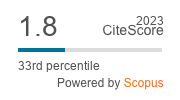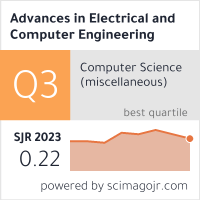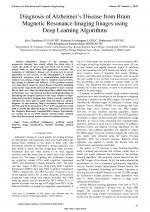| 3/2020 - 7 |
Diagnosis of Alzheimer's Disease from Brain Magnetic Resonance Imaging Images using Deep Learning AlgorithmsSUGANTHE, R. C. |
| View the paper record and citations in |
| Click to see author's profile in |
| Download PDF |
Author keywords
artificial intelligence, artificial neural network, image classification, machine learning, medical diagnosis
References keywords
disease(23), alzheimer(22), neural(7), prediction(6), learning(6), networks(5), diagnosis(5), deep(5), convolutional(5), techniques(4)
Blue keywords are present in both the references section and the paper title.
About this article
Date of Publication: 2020-08-31
Volume 20, Issue 3, Year 2020, On page(s): 57 - 64
ISSN: 1582-7445, e-ISSN: 1844-7600
Digital Object Identifier: 10.4316/AECE.2020.03007
Web of Science Accession Number: 000564453800007
SCOPUS ID: 85090360650
Abstract
Alzheimer's disease is one amongst the progressive disorder that cruelly affects the brain cells. It causes the death of nerve cells and tissue loss in brain. It usually tends to start slowly and aggravates overtime. The symptoms of Alzheimer's disease vary from person to person depending on the severity of the unhealthiness. It exhibits behavioral symptoms such as communication impairments, memory loss, taking a longer time to complete usual activities, and change in attitude and behavior. If the problem worsens over time, then it cannot be cured. Hence it should be identified at the earlier stage itself and treat the patient to lead a normal life on their own. Deep learning algorithms exhibit marvelous performance over conventional machine learning algorithms in identifying the complex patterns in the large volumes of high-dimensional medical imaging data. Hence, recently significant attention has been paid to apply deep learning for medical diagnosis. In this research, Deep Convolution Neural Network (DCNN) and VGG-16 inspired CNN (VCNN) models have been built to classify the different stages of Alzheimer's Disease from the Magnetic Resonance Imaging(MRI) images. Experiments are carried out on an ADNI dataset and the results obtained show that the proposed models achieved excellent accuracy. |
| References | | | Cited By «-- Click to see who has cited this paper |
| [1] C. Stolojescu-Crisan, S. Holban, "A comparison of x-ray image segmentation techniques," Advances in Electrical and Computer Engineering, vol.13, no.3, pp.85-92, 2013, [CrossRef] [Full Text] [Web of Science Times Cited 40] [SCOPUS Times Cited 63] [2] A. V. Lebedev, E. Westman, G. J. P. Van Westen, M. G. Kramberger, A. Lundervold, D. Larsland, et al., "Random Forest ensembles for detection and prediction of Alzheimer's disease with a good between-cohort robustness", NeuroImage: Clinical Journal, vol. 6, pp. 115-125, 2014, [CrossRef] [Web of Science Times Cited 189] [SCOPUS Times Cited 234] [3] U. R. Acharya, S. L. Fernandes, J. E. Wei Koh, E. J. Ciaccio, M. K. M. Fabell, U. J. Tanik et al. ,"Automated detection of Alzheimer's disease using brain MRI images- A study with various feature extraction techniques" Journal of Medical Systems, vol.43, no.9, pp.1-8,2019, [CrossRef] [Web of Science Times Cited 147] [SCOPUS Times Cited 246] [4] Mohamed M. Dessouky and Mohamed A. Elrashidy "Feature extraction of the Alzheimer's disease images using different optimization algorithms," Journal of Alzheimer's Disease & Parkinsonism , vol.6, no.2, pp.1-11, 2016, [CrossRef] [5] S. Liu, S. Liu, W. Cai, S. Pujol, R. Kikinis and D. Feng, "Early diagnosis of alzheimer's disease with deep learning," 2014 IEEE 11th International Symposium on Biomedical Imaging (ISBI), Beijing,July 31, pp. 1015-1018, 2014, [CrossRef] [SCOPUS Times Cited 441] [6] J. Dukart, K. Mueller, H. Barthel, A. Villringer, O. Sabri, M. L. Schroeter,"Meta-analysis based SVM classification enables accurate detection of alzheimer's disease across different clinical centers using FDG-PET and MRI," Psychiatry research, vol. 212, no.3, pp. 230-236, 2013, [CrossRef] [Web of Science Times Cited 100] [SCOPUS Times Cited 118] [7] K. Ota, N. Oishi, K. Ito, H. Fukuyama , J. Sead, Study Group & Alzheimer's Disease Neuroimaging Initiative, "Effects of imaging modalities, brain atlases and feature selection on prediction of Alzheimer's disease," Journal of Neurosci Methods, vol.256, pp.168-183,2015, [CrossRef] [Web of Science Times Cited 46] [SCOPUS Times Cited 54] [8] F. Malik, S. Farhan, M. A. Fahiem, "An ensemble of classifiers based approach for prediction of Alzheimer's disease using fMRI images based on fusion of volumetric, textural and hemodynamic features," Advances in Electrical and Computer Engineering, vol.18, no.1, pp.61-70, 2018, [CrossRef] [Full Text] [Web of Science Times Cited 6] [SCOPUS Times Cited 9] [9] A. Ayub, S. Farhan, M. A. Fahiem, H. Tauseef, "A novel approach for the prediction of conversion from mild cognitive impairment to Alzheimer's disease using MRI images," Advances in Electrical and Computer Engineering, vol.17, no.2, pp.113-122, 2017, [CrossRef] [Full Text] [Web of Science Times Cited 3] [SCOPUS Times Cited 4] [10] O. Geman, C. O. Turcu, A. Graur, "Parkinson's disease assessment using fuzzy expert system and nonlinear dynamics," Advances in Electrical and Computer Engineering, vol.13, no.1, pp.41-46, 2013, [CrossRef] [Full Text] [Web of Science Times Cited 26] [SCOPUS Times Cited 27] [11] J. Weller, & A. Budson, "Current understanding of Alzheimer's disease diagnosis and treatment," F1000 Research, 7,2018, [CrossRef] PMID: 30135715; PMCID: PMC6073093 [SCOPUS Times Cited 667] [12] M. W. Bondi, E. C. Edmonds, Salmon DP. "Alzheimer's disease: past, present, and future", J Int Neuropsychol Soc, vol.23(9-10), pp.818-831, 2017, [CrossRef] [Web of Science Times Cited 355] [SCOPUS Times Cited 424] [13] B. Dubois, A. Padovani, P.Scheltens, A. Rossi & G.Dell'Agnello, "Timely diagnosis for alzheimer's disease: A literature review on benefits and challenges", Journal of Alzheimer's Disease, vol. 49, no. 3, pp. 617-631, 2016 [CrossRef] [Web of Science Times Cited 342] [SCOPUS Times Cited 364] [14] M. Tanveer, B. Richhariya, R. U. Khan, A. H. Rashid, P. Khanna, M. Prasad et al., "Machine learning techniques for the diagnosis of Alzheimer's disease: A review," ACM Transactions on Multimedia Computing, Communications, and Applications (TOMM), vol.16,no.1S, pp.1-35, 2020, [CrossRef] [Web of Science Times Cited 202] [SCOPUS Times Cited 278] [15] C. K. Fisher, A. M. Smith, J. R. Walsh,"Machine learning for comprehensive forecasting of Alzheimer's disease progression," Science Reports 9, vol.13622, 2019, [CrossRef] [Web of Science Times Cited 103] [SCOPUS Times Cited 127] [16] J. De Velasco Oriol, E. E. Vallejo, K. Estrada, G. Tamez Pena and ADNI, "Benchmarking machine learning models for late-onset alzheimer's disease prediction from genomic data," BMC Bioinformatics 20, vol.709, 2019, [CrossRef] [Web of Science Times Cited 38] [SCOPUS Times Cited 49] [17] L. R. Trambaiolli, A. C. Lorena, F. J. Fraga, , P. A. M. Kanda, R. Anghinah & R. Nitrini, "Improving alzheimer's disease diagnosis with machine learning techniques," Clinical EEG and Neuroscience, vol.42, no.3, pp.160-165, 2011, [CrossRef] [Web of Science Times Cited 87] [SCOPUS Times Cited 114] [18] S. Basaia, F. Agosta, L. Wagner, E. Canu, G. Magnani, R. Santangelo et al., and Alzheimer's Disease Neuroimaging Initiative, "Automated classification of Alzheimer's disease and mild cognitive impairment using a single MRI and deep neural networks," NeuroImage: Clinical Journal,vol.21,no.1, pp.1-8, 2019, [CrossRef] [Web of Science Times Cited 357] [SCOPUS Times Cited 460] [19] O. Geman, H. Costin, "Automatic assessing of tremor severity using nonlinear dynamics, artificial neural networks and neuro-fuzzy classifier," Advances in Electrical and Computer Engineering, vol.14, no.1, pp.133-138, 2014, [CrossRef] [Full Text] [Web of Science Times Cited 28] [SCOPUS Times Cited 28] [20] Y. LeCun, Y. Bengio, G. Hinton "Deep learning," Nature, vol.521, no.1, pp.436-444,2015, [CrossRef] [Web of Science Times Cited 23572] [SCOPUS Times Cited 58868] [21] A. Krizhevsky, I. Sutskever, G. E. Hinton, "Imagenet classification with deep convolutional neural networks," Communication of the ACM, vol.60, no.6, pp.84-90,2017, [CrossRef] [Web of Science Times Cited 69776] [SCOPUS Times Cited 20499] [22] N. Sharma, V. Jain & A. Mishra, "An analysis of convolutional neural networks for image classification," Procedia Computer Science,vol.132, pp.377-384, 2018, [CrossRef] [SCOPUS Times Cited 418] [23] U. R. Acharya, S. L. Oh, Y. Hagiwara, J. H. Tan, H. Adeli, D. P. Subha "Automated EEG-based screening of depression using deep convolutional neural network," Computer Methods and Programs in Biomedicine, vol.161, pp.103-113, 2018, [CrossRef] [Web of Science Times Cited 365] [SCOPUS Times Cited 447] [24] S. E. Spasov, L. Passamonti, A. Duggento, P. Lio, N. Toschi , "A multi-modal convolutional neural network framework for the prediction of Alzheimer's disease," Conf Proc IEEE Eng Med Biol Soc. 2018, pp.1271â1274, 2018, [CrossRef] [SCOPUS Times Cited 55] [25] A. Payan, G. Montana, "Predicting Alzheimer's disease: A neuroimaging study with 3D convolutional neural networks," arXiv, February 10, 2015, arXiv:1502.02506 [26] J. Nowaková, M. Prilepok & V. Snášel, "Medical image retrieval using vector quantization and fuzzy S-tree," Journal of Medical Systems, vol. 41, no. 18, pp. 1-16, 2017, [CrossRef] [Web of Science Times Cited 66] [SCOPUS Times Cited 76] [27] Elena-Lorena Hedrea, Radu-Emil Precup, Claudia-Adina Bojan-Dragos, "Results on tensor product-based model transformation of magnetic levitation systems," Acta Polytechnica Hungarica, vol. 16, no. 9, pp. 93-111, 2019. [28] R. P. Gil, Z. C. Johanyák & T. Kovács, "Surrogate model based optimization of traffic lights cycles and green period ratios using microscopic simulation and fuzzy rule interpolation," International journal of artificial intelligence, vol.16, pp.20-40,2018, Corpus ID: 53310666 [29] T. Haidegger, L. Kovacs, S. Preitl, R. E. Precup, B. Benyo, Z. Benyo, "Controller design solutions for long distance telesurgical applications," International Journal of Artificial Intelligence, vol. 6, no.11S , pp. 48-71,2011. [30] https://fsl.fmrib.ox.ac.uk/fsl/fslwiki [31] M. Jenkinson, C. Beckmann, T. E. J. Behrens, M. W. Woolrich, S. M. Smith, "FSL," NeuroImage, vol.62, no.2, pp.782-790, 2012, [CrossRef] [Web of Science Times Cited 7532] [SCOPUS Times Cited 7740] Web of Science® Citations for all references: 103,380 TCR SCOPUS® Citations for all references: 91,810 TCR Web of Science® Average Citations per reference: 3,231 ACR SCOPUS® Average Citations per reference: 2,869 ACR TCR = Total Citations for References / ACR = Average Citations per Reference We introduced in 2010 - for the first time in scientific publishing, the term "References Weight", as a quantitative indication of the quality ... Read more Citations for references updated on 2024-10-14 18:00 in 203 seconds. Note1: Web of Science® is a registered trademark of Clarivate Analytics. Note2: SCOPUS® is a registered trademark of Elsevier B.V. Disclaimer: All queries to the respective databases were made by using the DOI record of every reference (where available). Due to technical problems beyond our control, the information is not always accurate. Please use the CrossRef link to visit the respective publisher site. |
Faculty of Electrical Engineering and Computer Science
Stefan cel Mare University of Suceava, Romania
All rights reserved: Advances in Electrical and Computer Engineering is a registered trademark of the Stefan cel Mare University of Suceava. No part of this publication may be reproduced, stored in a retrieval system, photocopied, recorded or archived, without the written permission from the Editor. When authors submit their papers for publication, they agree that the copyright for their article be transferred to the Faculty of Electrical Engineering and Computer Science, Stefan cel Mare University of Suceava, Romania, if and only if the articles are accepted for publication. The copyright covers the exclusive rights to reproduce and distribute the article, including reprints and translations.
Permission for other use: The copyright owner's consent does not extend to copying for general distribution, for promotion, for creating new works, or for resale. Specific written permission must be obtained from the Editor for such copying. Direct linking to files hosted on this website is strictly prohibited.
Disclaimer: Whilst every effort is made by the publishers and editorial board to see that no inaccurate or misleading data, opinions or statements appear in this journal, they wish to make it clear that all information and opinions formulated in the articles, as well as linguistic accuracy, are the sole responsibility of the author.





